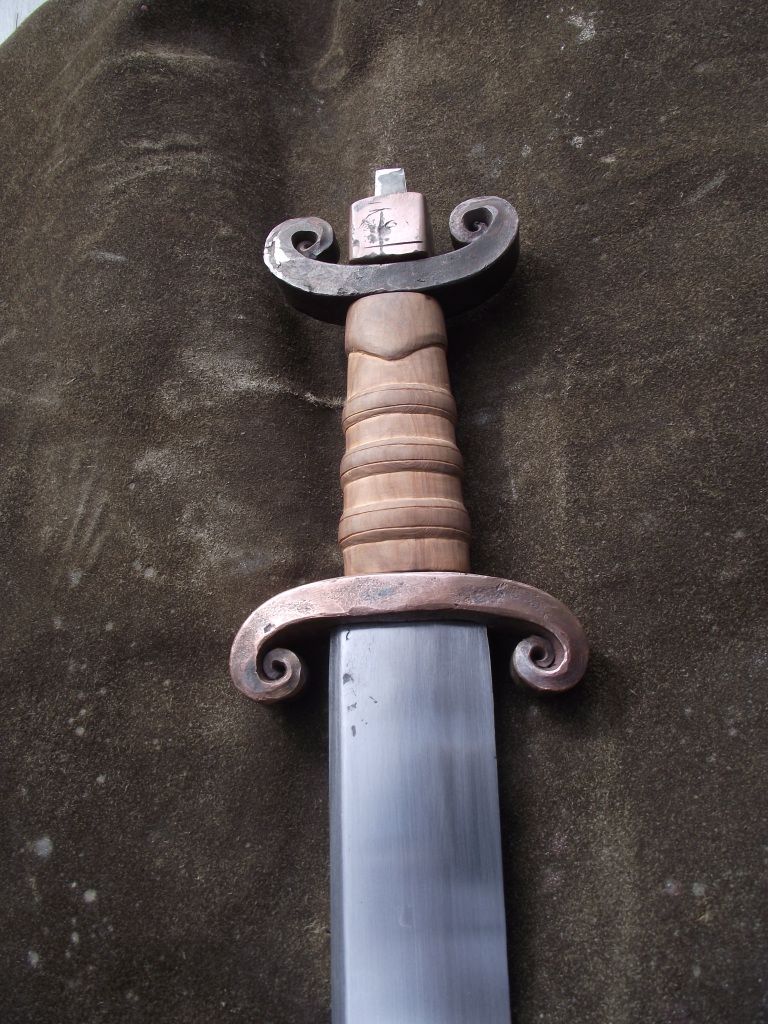This sword is the brother to the one shown here some time
ago in every sense, made from the same antique metal, made by the same method
and the same hand.
They are also a pair in their purpose as symbols of
dedication, heritage and protection to be exchanged between Bride and Groom.
So, the piece in question was begun in this way, a stack is welded together and folded a dozen
times to create a unique, new piece of steel that aims for homogeneity but
achieves the lustrous, patterned metal that enticed our ancestors.
Loud Video!
This folded steel is then drawn out into a long bar and
divided in two.
Between these two pieces a new piece of low carbon mild
steel is forge welded in, forming a “core” to the blade.
The Tang was forge welded on separately. This method was
widely used in the past.
At this final stage, I noticed some cracks at the tip of the
sword, and on closer inspection it seemed likely that I had overheated this
part of the blade during the forge welding. This presented a quandary as I did
not want to start the blade again due to the significance held with both swords
being made from the same steel, but I also could not satisfactorily finish and
deliver a sword with such flaws.
So it became clear to me that I needed to repair this sword.
Many ancient blades exhibit evidence of having been reforged
or welded at some point during their life. The sagas tell us that breakages
were a fairly common outcome of sword fighting and craftsman of the day had to
repair those blades deemed too valuable to simply discard as broken.
This is quite an achievement as a sword that breaks in use
is a sword that has been finished, has been ground and polished and is thus-
thin. Too thin perhaps for most smiths of any era to confidently re- forge weld
flawlessly to condition that the blade can be re-hardened, re- polished and
returned to use. But, this they did.
With this is mind I began preparing for the repair which firstly
involved making more folded steel.
The damaged area of the tip was cut off and the folded steel
was forged and divided into two pieces, each piece being carefully formed to
the tapering shape of the new tip.
The new steel was welded very carefully as a single
misplaced hammer blow would leave an impression beyond what could be removed
with careful grinding and polishing.
This was perhaps the most intense 20 minutes of forging I
have ever done and I am proud to say that the result was a flawless weld that
is as strong, if not stronger than the rest of the sword.
The fact that this area welded so well can be seen in the
final polish and etch of the blade, where the decorative grain of the sword
suddenly changes to the new steel. The contrast has to be looked for to be
found but is an element of detail unique to the life story of this blade and I
feel adds to the sense of history this sword.
Careful etching reveals the subtle character of the steel.
The hilt on this sword was a lot more intricate and involved
than the hilt parts of the first sword. The pommel is loosely inspired by
type B as if tapers in two directions. The rough form was forged and hot
punched with a drift that was the clone of the tang, ensuring a tight fit with
no need for fettling.
The top and bottom guard were to be overlaid with brass and
copper. This challenging technique was very popular form of hilt embellishment
for centuries and involves the careful preparation of hundreds of grooves,
undercut and inlaid with wire. The wire is then planished (hammered with a
small hammer with a polished face) this method spreads the wires until they butt
up against each other.
To commemorate the repair or healing of this blade I inlayed this symbol into the pommel.
Eventually, the entire surface of the guards was covered in this way.
To commemorate the repair or healing of this blade I inlayed this symbol into the pommel.
A wooden core was made from Pear wood, this will be wrapped
with brass wire to add another layer of detail and decoration.
As whole as these look, they aren’t yet fixed together. The peening
of the tang is left to the very last moment to allow for small adjustments. When
this final act has been finished, the swords are together, one object made from
many pieces. They come to life at this point their balance is final and they finally
feel like a sword.

























